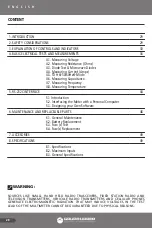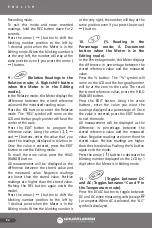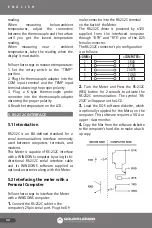
E N G L I S H
36
readings due to the high input impedance.
This is normal. When you connect the
test leads to a circuit, a real measurement
appears.
Using holster and stand
This Meter comes with a protective holster
that absorbs shocks and protects the
Meter from rough handling. The holster is
equipped with a stand rest.
4. BASIC ELECTRICAL TESTS AND
MEASUREMENTS
4.1 Measuring voltage
WARNINGS: TO AVOID THE RISK OF
ELECTRICAL SHOCK AND INSTRUMENT
DAMAGE, INPUT VOLTAGES MUST NOT
EXCEED 1000V DC OR 750V AC (RMS). DO
NOT ATTEMPT TO TAKE ANY UNKNOWN
VOLTAGE MEASUREMENT THAT MAY BE IN
EXCESS OF 1000V DC OR 750V AC (RMS). THIS
METER IS DESIGNED FOR MEASUREMENT IN
WEAK CURRENT CIRCUITS. DO NOT USE IT
FOR STRONG CURRENT CIRCUITS. DO NOT
USE IT FOR STRONG CURRENT CIRCUITS
(POWER LINE IN FACTORIES AND SO ON
HAVING LARGE CURRENT CAPACITY). USE
IN STRONG CURRENT CIRCUITS IS VERY
DANGEROUS BECAUSE SURGE VOLTAGE IN
FAR EXCESS OF RATING IS OFTEN APPLIED
TO THEM.
NOTE: When taking voltage measurements,
this Meter must be connected in PARALLEL
with the circuit, or circuit element under
test.
• In 400mV range, displayed value may
fluctuate when disconnecting input
terminals. This is normal.
• AC voltage measuring circuit in this
Meter is of root-mean-square (True-RMS)
value system so this Meter can accurately
measure AC voltage of non-sinusoidal
wave forms including harmonics caused
by various non-liner loads. For an AC
Voltages (or current) Meter, CREST
FACTOR expresses its ability to respond
to non-sinusoidal wave-forms. (CREST
FACTOR is defined as the ratio of the peak
voltage of an AC waveform to its RMS
value). The AC crest factor of this Meter
is 3 for the frequency range of 45Hz to
1KHz.
• To improve the accuracy of DC voltage
measurements taken in the presence of
AC voltages (such as, measuring the DC
voltage of an amplifier in the presence
of an AC signal), measure the AC voltage
first. Note the just measured AC voltage
range and select a DC voltage range that
is the same of higher than the AC voltage
range. This method improves the DC
voltage accuracy by preventing the input
protection circuits from being activated.
4.1.1 Measuring DC Volts
Follow these steps to measure DC volts:
1. Set function and range switch to the
desired DC V range. If you do not know the
value of the voltage to be measured, always
start with the highest range and reduce the
setting as required to obtain a satisfactory
reading.
2. Plug the red test lead into the “VΩHz
CAP“ input terminal and the black lead
into the “COM” input terminal of the
instrument.
3. Disconnect the power from the circuit to
be tested.
4. Connect the test leads to the circuit to be
tested.
5. Reapply power to the circuit, the
measured voltage will appear on the display
of the instrument.
6. If the red test lead is connected to the
















































